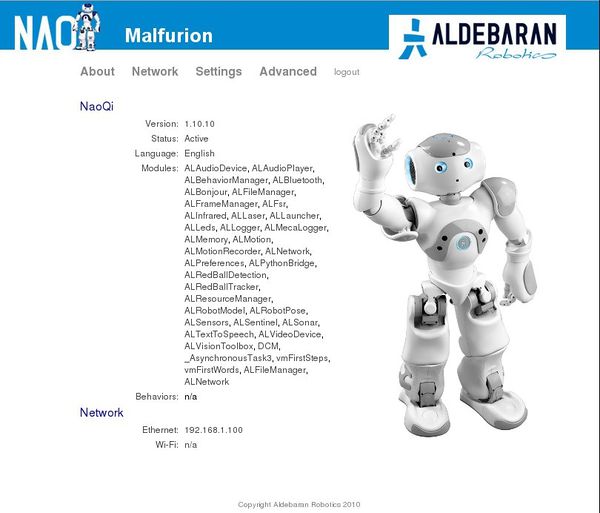Nao tutorial 1: First steps
This article is unfinished. Content may vary without notice. Please, do not edit it if you're not the original author.
The purpose of this tutorial is to teach you the basic concepts of Nao. I assume that you are staring at the robot's box after (hopefully) buying it, and that you want to start making cool things with it, like conquering the world. You are wondering how to do that, but you don't even know how to plug the robot.
I will take you, step by step, through the first tasks that you should complete before going serious. Even if I will try to make it easy, certain previous knowledge is required, like basic programming and Linux concepts. Also, I would recommend you to read the official documentation and tutorials found here (section "Software") before going forth. In case of doubt, always trust them.
This tutorial is targeted for version 1.10.10 of the SDK and OS. Older versions like 1.8.16 or 1.6.13 are not likely to work.
Contents
Preparing the environment
OK, the first thing you should do is to get a testing environment ready. By "testing environment" I mean:
- A room with enough space.
- A computer running Linux (Debian or Ubuntu preferably).
- A simple LAN with a router.
Be aware that Nao is very prone to fall if you do something wrong. Don't be afraid, but keep it in mind.
Let's begin. Place Nao somewhere in the middle of the room, so he has freedom of movement. Try to keep it apart from places or objects that could make him fall or get jammed. Also, note that you will eventually need to plug it to the power (whenever you need to recharge his battery), and to the LAN (in case he is not able to connect wirelessly). The power connector is on Nao's back, facing downwards. In fact, you will be plugging it directly to the battery, which is behind the cover (it has 4 screws that you must remove in order to access it).
Finally, the Ethernet socket is located behind the head. You may need to open the protective hatch, or completely remove the head's cover, whichever one you prefer.
Connecting to Nao
When everything is set, press Nao's chest button once to turn it on. His eyes will start blinking red, green and blue. Then, some other blue LEDs located on his ears will do the same, and the eyes will stop blinking. Later, both the eyes and chest button will come alive again with a stable white light, and the robot will tell you that it has finished loading his system. The whole process lasts about two minutes and you will get soon tired of it, I promise.
Now, you must connect to Nao to do some first-time configuration. It pays to have a simple router-based LAN with DHCP dynamic addressing, otherwise you will complicate your life, trust me.
Recovering the IP address
We need to get the IP address Nao has bonded to, before trying to connect to him. There are a couple of ways to do it, some easier than others, and I will enumerate them all:
Using the router
This is the hard way. Most routers offer an option to list the clients that are connected to it, through the web interface. But you need the router's IP. Input the following command in your PC (obviously, you must be in the same LAN as Nao):
sudo ifconfig
Seek your network adapter in the list (usually eth0 for the first Ethernet card, eth1 for the second...) and look for your IP address (mine is 192.168.1.101). Your router's IP will be probably the same, only changing the last number for 1 or 0 (e.g., 192.168.1.1). Open a web browser and input that IP in the address bar. Press Enter and you will be prompted for the router's username and password. You should know them, but if that's not the case go here for a list of default ones.
When you're in, seek for a menu option that will show you the connected clients. Nao's IP should be next to yours.
Mapping the network
Easier than the previous. You can scan the network for online hosts, using a network mapper program. For example, I will use nmap. Install it using the following command if you are using Debian or Ubuntu:
sudo apt-get install nmap -y
And then do a ping scan over your network (change the first three numbers of the IP to match your network):
sudo nmap -sP 192.168.1.1-255
Nao will appear in the list, with something like "Host 192.168.1.102 is up (0.00018s latency)". Your own computer will be shown, but with no latency.
Asking Nao
The easier way, but you will need to get up and walk a bit. Just approach Nao and press his chest button once. It will briefly blink in green, and then Nao will beep and speak his name, internet address and battery level. If it says "I can't connect to the network", check the router and Ethernet cable.
Web interface
Open a web browser, enter your Nao's IP as destination and hit Enter. If everything went OK, you should now see the robot's web interface (a login screen) appear. Enter "nao" as both the username and password and press Enter.
The "About" screen will welcome you. Here you can check a lot of useful data about your robot, like the OS version he is running, which modules has he loaded, etc. Clicking on a module's name will show the available methods that it implements, and their descriptions. Quite handy.
When you're done, go to the "Network" menu. Here you will see a list of wireless networks, that Nao has detected using his wifi card.

